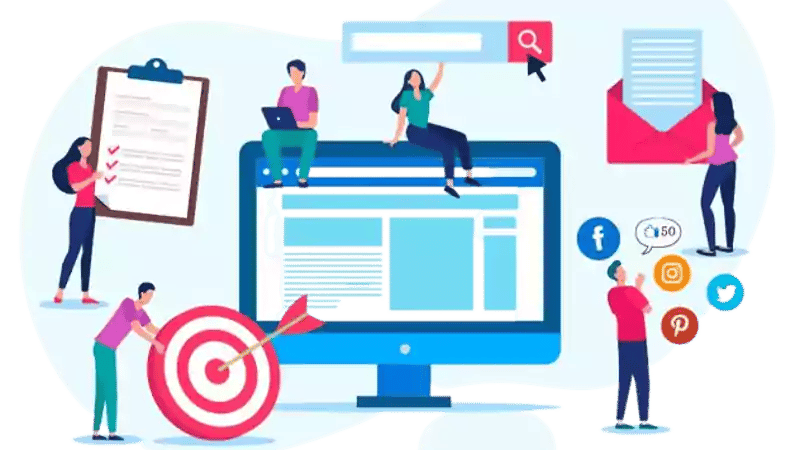The Buyer's Journey: Best Content for the Consideration Stage
Imagine a customer who's window-shopping... for your product! They've acknowledged they need a solution, and your business is one of the possibilities. But with countless options out there, how do you get them to step inside your store (or click "add to cart")?
The answer: content specifically curated for the consideration stage of the buyer's journey.

Understanding the Buyer's Journey: Consideration Stage
The consideration stage is the pivotal point in the buyer's journey, where potential customers actively evaluate their options before making a purchase decision. Unlike the awareness stage, where individuals become familiar with a problem, the consideration stage signifies a deeper level of engagement. It's characterized by a heightened interest in finding viable solutions and exploring different products or services.
The significance of this stage lies in its role as the bridge between awareness and decision-making. Consumers delve into detailed research during the consideration stage, seeking comprehensive information to inform their choices. Crafting content tailored to this phase becomes imperative, as it directly influences whether a potential lead progresses toward conversion or decides to explore alternative options.
Understanding the mindset of buyers in the consideration stage is paramount to creating content that resonates. At this juncture, consumers are actively seeking solutions to their problems. They're open to exploring various options, comparing features, and evaluating each solution's value. The mindset shifts from a general awareness to a more focused consideration of specific products or services that align with their needs.
The Role of Content
During this stage, consumers exhibit a higher level of engagement and intent. They are hungry for in-depth information, seeking details beyond surface-level overviews.
As such, the consideration stage requires content that balances informative and persuasive. It's not just about making consumers aware of your offerings; it's about guiding them through the evaluation process. Content tailored for this stage should provide value-driven information, addressing specific pain points and positioning your product or service as a viable and superior choice.
Best Content for the Consideration Stage
1. In-depth Guides and Whitepapers
In the consideration stage, where potential customers actively seek comprehensive insights, in-depth guides, and whitepapers are invaluable tools. These content formats provide an opportunity to delve deep into complex topics, offering a wealth of information beyond the surface.
83% of B2B buyers say white papers influence their purchase decisions.
In-depth guides serve as detailed roadmaps, guiding consumers through various product or service aspects. These can include how-to guides, feature breakdowns, and comparisons with competing solutions. On the other hand, whitepapers add an element of authority, presenting well-researched data, industry trends, and expert analyses. Together, they cater to the discerning audience in the consideration stage, addressing their thirst for knowledge and aiding them in making informed decisions.
2. Case Studies Highlighting Success
Human beings are inherently drawn to stories, and in the consideration stage, presenting real-life success stories through case studies becomes a potent strategy. These narratives offer a tangible connection to the product or service, showcasing its impact in solving problems and delivering tangible results.
68% of B2B buyers rate case studies as a helpful source of information when making purchasing decisions.
Case studies bring authenticity to the forefront, portraying how your offering has positively influenced others in similar situations. By highlighting challenges, the solution implemented, and the subsequent outcomes, potential customers gain a nuanced understanding of your product or service's practical applications and effectiveness. This personalized storytelling approach resonates with the consideration stage audience, instilling confidence and trust in your brand.
3. Interactive Content: Quizzes, Assessments, and Surveys
In the era of digital engagement, interactive content has emerged as a dynamic force, especially in the consideration stage. Quizzes, assessments, and surveys offer a two-way communication channel, actively involving potential customers in the decision-making process.
Quizzes provide an engaging way to guide users through self-discovery, helping them understand their needs and preferences. Assessments allow for personalized recommendations based on user input, tailoring the information to individual requirements. Surveys, on the other hand, gather valuable feedback, fostering a sense of collaboration between the brand and the potential customer.
The allure of interactive content lies in its ability to transform the decision-making journey into an experiential process. It captures attention and ensures active participation, making the consideration stage more memorable and impactful. By incorporating gamification elements, such as scoring or rewards, interactive content transforms the decision-making process into an enjoyable and informative experience.
4. Blog Articles
Consideration-stage blogs play a crucial role in providing detailed insights and guidance. Unlike awareness blogs that introduce general concepts, consideration blogs zoom in on specific aspects related to the decision-making process. They address common questions and concerns when individuals actively weigh their options. Consideration blogs become educational resources, offering valuable information that aligns with the audience's evolving needs, bridging awareness and the final decision.
47% of buyers read at least 3-5 pieces of content during the consideration stage, often including product comparisons.
The objective is to provide potential customers with insights beyond surface-level information, addressing their specific concerns and actively contributing to their decision-making journey. The blogger's task is to create content that engages, informs, and persuades the audience to consider the brand's offerings seriously.
Key elements to include in a consideration stage blog post:
-
Blog headlines that grab attention: Crafting compelling headlines is the gateway to capturing the audience's attention. Consideration-stage blog headlines should be intriguing, relevant, and pique the reader's curiosity. These headlines serve as the initial hook, enticing visitors to explore further.
-
Address common questions: Consideration-stage content should act as an informative resource, answering the questions that potential customers commonly ask during this phase. The content establishes itself as a valuable guide by addressing these queries and helping readers make informed decisions.
-
Balance information and persuasion: Striking the right balance between providing information and incorporating persuasive elements is crucial. While the content should be informative and insightful, it should also subtly persuade the reader to consider the brand's product or service as a viable solution.
Using the "BARB" framework –Benefits, Alternatives, Risks, and Best Practices– can be helpful during this stage. Addressing the benefits of the product or service, presenting alternatives, discussing potential risks, and offering best practices ensure a well-rounded exploration of key considerations in the blog.
Blog Headlines for the Consideration Stage
Crafting headlines for the Consideration Stage is an art that requires a deep understanding of the audience's mindset. The headlines should be compelling, offering a glimpse into the valuable information the blog provides. They must be concise yet powerful, driving curiosity and encouraging readers to explore further.
Strategic inclusion of keywords is vital for enhancing search engine visibility. Consideration-stage blog headlines should incorporate relevant keywords that align with what potential customers are likely to search for. This optimization ensures that the content is easily discoverable by individuals actively exploring solutions.
Here are some examples of strong headlines for consideration stage blogs:
-
Headlines that address pain points and offer solutions
-
Frustrated with [Problem]? Here's How to Finally Overcome It
-
Feeling Overwhelmed by [Choice]? This Guide Makes It Easy
-
Unsure if [Product/Service] is Right for You? Read This First.
-
-
Headlines that use numbers and data to build trust
-
5 Proven Ways to [Achieve Goal] in Just [Timeframe]
-
Stats Don't Lie: Why You Should Consider [Product/Service]
-
Top 3 Alternatives to [Competitor] for [Target Audience]
-
-
Headlines that use social proof and testimonials
-
The Secret to [Success] Nobody Talks About (But You Need to Know)
-
This One Trick Could Change Your [Life/Business] Forever
-
What You Don't Know About [Topic] Could Cost You Big
-
-
Headlines that spark curiosity and intrigue
-
Case Study: How [Company] Achieved [Results] with [Product/Service]
-
See Why These Experts Recommend [Product/Service]
-
-
Headlines that are specific and action-oriented
-
Ready to Launch Your Business? Get Your Free Checklist Now
-
Download Our Guide to Choosing the Right [Product/Service]
-
Limited Time Offer: Try [Product/Service] Risk-Free for 30 Days
-
Bonus tips:
- Keep your headlines concise, ideally under 70 characters.
- Use keywords relevant to your target audience and SEO.
- Create a sense of urgency or exclusivity to encourage clicks.
- Test different headlines to see what resonates best with your audience.
While each content type holds unique strengths, a holistic approach to content creation in the consideration stage often involves combining these elements. In-depth guides and whitepapers provide the necessary depth and detail, case studies add a human touch with real-world examples, and interactive content injects a sense of engagement and participation.
By weaving these content types into a cohesive strategy, marketers can cater to the diverse preferences of potential customers in the consideration stage. This comprehensive approach educates and nurtures leads, guiding them toward the final decision-making phase with a well-informed and engaged mindset.
Questions Your Prospects Ask in the Consideration Stage
1. "What are the key features of your product or service?"
Prospects want a detailed breakdown of the features your offering provides to assess how well it aligns with their needs.
2. "How does your product compare to competitors in the market?"
Comparative insights help prospects understand what sets your product apart and why it might be the superior choice.
3. "Can you provide real-world examples or case studies of successful implementations?"
Case studies offer tangible evidence of your product's effectiveness and provide a sense of its practical applications.
4. "What benefits will I gain by choosing your solution?"
Prospects seek a clear understanding of the specific advantages and value propositions your product or service brings to the table.
5. "Are there different pricing plans or options available?"
Clarity on pricing structures ensures prospects can evaluate the financial aspect of their decision and choose a plan that fits their budget.
6. "How is your customer support and post-purchase service?"
Questions about customer support and post-purchase services indicate prospects' concerns about long-term satisfaction and support.
7. "Do you offer a trial or demo to experience your product/service firsthand?"
A hands-on experience is often sought after to gauge the product's usability and suitability for their specific needs.
8. "Can you provide testimonials from current or past customers?"
Testimonials add credibility and provide social proof, helping prospects build trust in your brand and offering.
9. "What integrations or compatibility options does your product/service have?"
Prospects want to ensure seamless integration with their existing tools and systems, minimizing disruptions.
10. "How does your product contribute to solving my specific challenges?"
Tailor your responses to address the prospect's unique challenges, showcasing how your solution is the right fit for their needs.
Step-by-Step Guide to Building Content for the Consideration Stage
-
Understand your audience. Begin by comprehending your target audience's needs, pain points, and preferences in the consideration stage. Conduct thorough research to identify their specific questions and concerns as they contemplate various options.

-
Define key topics. Once you clearly understand your audience, outline key topics that align with the considerations typical of this stage. These could include detailed product/service features, comparisons with competitors, success stories, and any other relevant information that aids in decision-making.
-
Craft attention-grabbing headlines. Start your content creation with attention-grabbing headlines. These should be compelling and indicative of the value your content provides. Consider using language that resonates with the audience's curiosity and emphasizes the benefits they seek.
-
Address common questions. Develop your content to address your audience's common questions directly and concerns during the consideration stage. Provide clear, concise answers that offer valuable insights and showcase your brand as an authoritative source in the industry.
-
Balance information and persuasion. Strike a delicate balance between providing informative content and incorporating persuasive elements. While the information should be comprehensive and unbiased, infuse persuasive language that subtly guides the reader toward considering your product or service as a viable solution.
-
Use various content formats. Diversify your content by incorporating various formats such as in-depth guides, case studies, interactive elements like quizzes or assessments, and well-crafted blog posts. Different formats cater to varied preferences, ensuring a more engaging and comprehensive approach.
-
Optimize for search engines. Incorporate relevant keywords naturally within your content to enhance its visibility on search engines. This ensures that your content reaches potential customers actively seeking information during the consideration stage.
-
Promote user engagement—foster engagement by encouraging comments, questions, and sharing of your content. Actively participate in discussions to address further queries and build a community around your brand.
Following this step-by-step guide, you can create tailored content for the consideration stage. This strategic approach helps potential customers make informed decisions and positions your brand as a reliable and valuable resource throughout their decision-making journey.
Guiding Consumers Strategically Through the Consideration Stage
The second stage in the buyer's journey is critical, transitioning potential customers from awareness to decision. This guided transition involves crafting content that informs and influences, laying the groundwork for conversion opportunities. Informative blog posts, in-depth whitepapers, and case studies are excellent ways to continue educating potential customers about your solution. You aren't entirely selling your product yet, but you're continuing to demonstrate your value and offer it as the solution to customers' problems.
By integrating these pieces of strategic content into your inbound marketing strategy, you can make lasting connections (that hopefully lead to conversions).
Once you've aced the consideration stage, it's time to prepare for the final stage of the buyer's journey: decision.










Leave a Comment